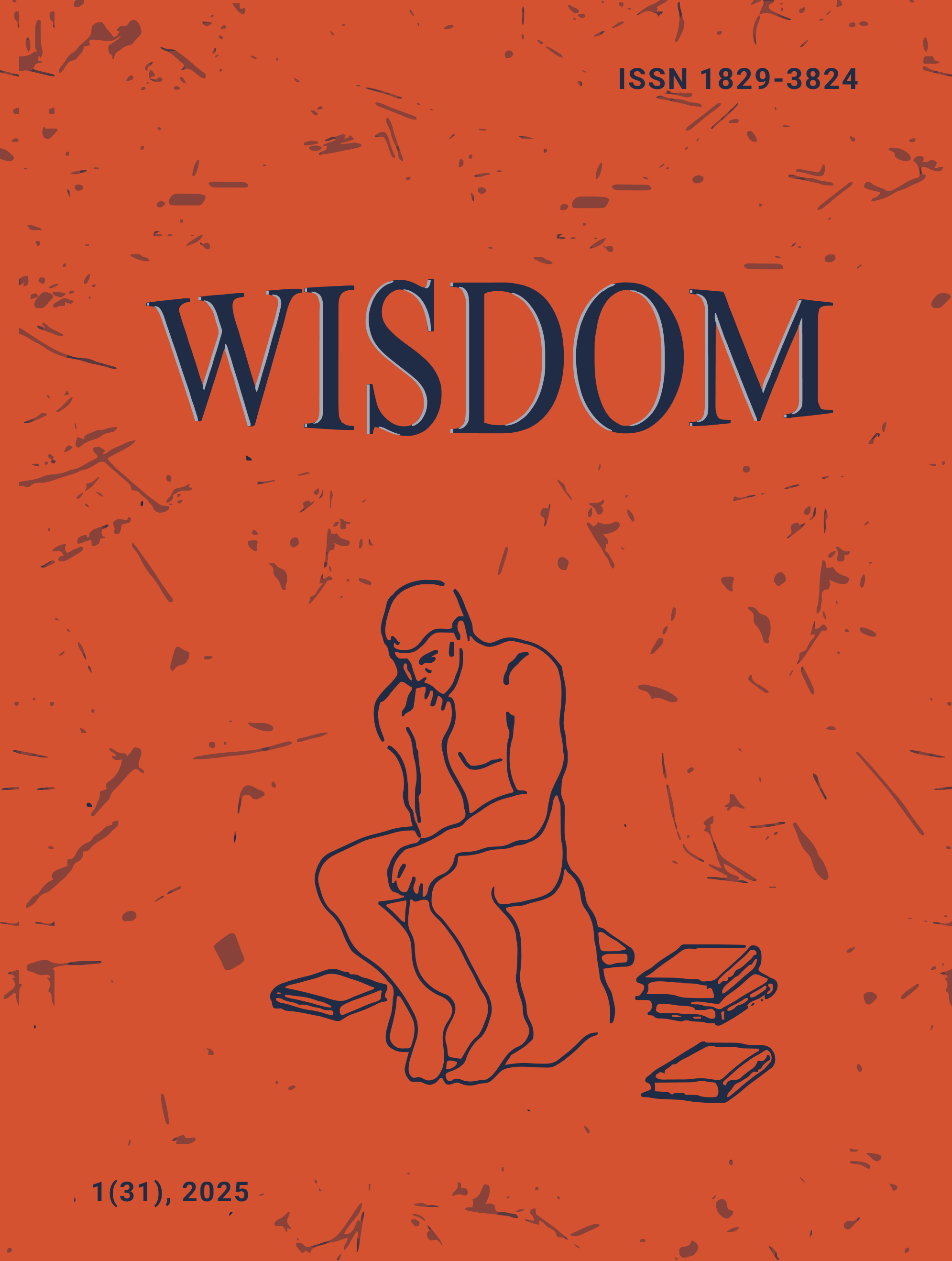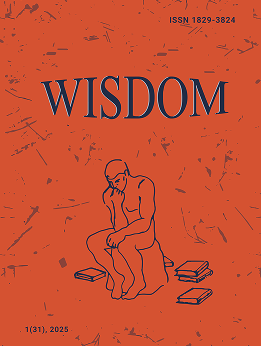The Main Advantages and Disadvantages of Soft and Hard Security Policies
DOI:
https://doi.org/10.24234/wisdom.v31i1.1123Keywords:
security, international relations, state politics, system, process, strategy, concept, legislation, challenge, philosophyAbstract
The article highlights the main advantages and disadvantages of security policy as the philosophy of national security. It presents the philosophical basis of national security idea in the context of changing international relations in recent decades, largely driven by globalization, technological advancements, and the emergence of new threats. Ensuring national security, which is already a crucial component of modern foreign policy, is achieved through various practical measures. Among these, two opposing approaches stand out: soft security policy and hard security policy. These approaches play an important role in determining how states respond to threats and what kind of relationships they form with other countries. Soft security policy involves the use of diplomacy, economic, and cultural means to exert influence in the international arena. In contrast, hard security policy is traditionally associated with the use of force, sanctions, and the deployment of military resources to eliminate external threats. Both of these approaches have their strengths and weaknesses, making it essential to assess how they interact with each other and their place in contemporary international relations. The main aim of this article is to provide a fundamental comparative analysis of the two approaches by examining their characteristics, advantages, and disadvantages.
Downloads
References
Barr, M., Feklyunina, V., & Theys, S. (2015). Introduction: The Soft Power of Hard States. Politics, 35(3-4), 213–215. http://dx.doi.org/10.1111/1467-9256.12210 DOI: https://doi.org/10.1111/1467-9256.12210
Bercovitch, J., & Gartner, S. (2006). Is There Method in the Madness of Mediation? Some Lessons for Mediators from Quantitative Studies of Mediation. International Interactions, 32(4), 329–354. https://doi.org/10.1080/03050620601011024 DOI: https://doi.org/10.1080/03050620601011024
Chufrin, G. I. (2022). Role of the CSTO in Promotion of Collective Security. Federalism, 27, 3, 77–88. http://dx.doi.org/10.21686/2073-1051-2022-3-77-88 DOI: https://doi.org/10.21686/2073-1051-2022-3-77-88
De Martino, M. (2020). Soft Power: Theoretical Framework and Political Foundations. Przegląd Europejski, 4, 11–24. http://dx.doi.org/10.31338/1641-2478pe.4.20.1 DOI: https://doi.org/10.31338/1641-2478pe.4.20.1
Fenenko, A. (2021). Anti-Soft Power in Political Theory and Practice. International Trends, 18(1), 40–71. http://dx.doi.org/10.17994/it.2020.18.1.60.3 DOI: https://doi.org/10.17994/IT.2020.18.1.60.3
Ferreira-Pereira, L., & Pinto, M. J. (2021). Soft Power in the European Union’s Strategic Partnership Diplomacy: The Erasmus Plus Programme. The European Union’s Strategic Partnerships, 69-94. https://10.1007/978-3-030-66061-1_4 DOI: https://doi.org/10.1007/978-3-030-66061-1_4
Filimon, L.-M. (2016). An Overview of the Copenhagen School’s Approach to Security Studies: Constructing Security Through Performative Power. The Romanian Journal for Baltic and Nordic Studies, 8(2), 47-48. Retrieved April, 21, 2025 from https://www.academia.edu/38227272/An_Overview_of_the_Copenhagen_School_s_Approach_to_Security_Studies_Constructing_In_Security_Through_Performative_Power DOI: https://doi.org/10.53604/rjbns.v8i2_4
Ghevondyan, A. (2018). The Role and Importance of Armenia-NATO Partnership in the Context of the RA Military-Political Security. YSU Journal of International Affairs, 9(3), 39-46. https://journals.ysu.am/index.php/bulletin-ysu-int-rel-pol/article/view/Vol.27_No.3_2018_pp.39-46
Guseletov, B. (2021). On the Interaction of EURO Parties with Parties from the Eastern Partnership Countries. Part 1. Scientific and Analytical Herald of IE RAS 24, 6, 32–40. http://dx.doi.org/10.15211/vestnikieran620213240 DOI: https://doi.org/10.15211/vestnikieran620213240
Ilgen, T. L. (2016). Hard Power, Soft Power and the Future of Transatlantic Relations. Taylor & Francis Group. DOI: https://doi.org/10.4324/9781315586199
Kocharyan, T. T. (2012). Ensuring the Military Security of the Republic of Armenia in the Context of National Security.Yerevan, YSU Publishing House.
Lackey, D. P. (2015). Soft Power, Hard Power, and Smart Power. Philosophical Forum, 46(1), 121-26. http://dx.doi.org/10.1111/phil.12059 DOI: https://doi.org/10.1111/phil.12059
Lebovic, J. H., (2019). The Iraq War, 2003–2011, In Planning to Fail: The US Wars in Vietnam, Iraq, and Afghanistan, New York. https://doi.org/10.1093/oso/9780190935320.003.0003 DOI: https://doi.org/10.1093/oso/9780190935320.003.0003
Mälksoo, M. (2024). NATO’s New Front: Deterrence Moves Eastward. International Affairs, 100(2), 531–547. https://doi.org/10.1093/ia/iiae008 DOI: https://doi.org/10.1093/ia/iiae008
Matlary, J. H. (2018). Hard Power in Hard Times. Cham: Springer International Publishing. http://dx.doi.org/10.1007/978-3-319-76514-3 DOI: https://doi.org/10.1007/978-3-319-76514-3
McBride, J., Berman, N., & Chatzky, A. (n.d.). China’s Massive Belt and Road Initiative. In Website of Council on Foreign Relations. Retrieved March, 03, 2025 from https://www.cfr.org/backgrounder/chinas-massive-belt-and-road-initiative
Norris, J., & Malknecht, A. (2014). Smart Power, Where Development and Defence Meet. In Support the Guardian. Retrieved March, 12, 2025 from https://www.theguardian.com/global-development-professionals-network/2013/oct/18/us-security-defence-departments-usaid
Nye, Jr., & Joseph, S. (2005). Soft Power: The Means to Success in World Politics. PublicAffairs Books. http://www.publicaffairsbooks.com/publicaffairsbooks-cgi-bin/display?book=1586482254
Nye, Jr., & Joseph, S. (2007). The Soft Power of the United Nations. Retrieved March, 02, 2025 from https://www.project-syndicate.org/commentary/the-soft-power-of-the-united-nations
Raik, K. (2022). Connectivity of the EU’s Eastern Partnership region: contestation between liberal and illiberal approaches. Journal of Contemporary European Studies, 31(4), 1122–1134. https://doi.org/10.1080/14782804.2022.2064441 DOI: https://doi.org/10.1080/14782804.2022.2064441
Sargsyan, A., & Kocharyan, T. (2016). Strategic Defense Review in the Context of Defense Reforms. Main Issues of Pedagogy and Psychology, 4(1), 142-149. https://doi.org/10.24234/miopap.v4i1.195 DOI: https://doi.org/10.24234/miopap.v10i1.195
Sperling, J., & Webber, M. (2018). NATO Operations. In H. Meijer, M. Wyss (Eds). The Handbook of European Defence Policies and Armed Forces (pp. 888-914). Oxford Academic. https://doi.org/10.1093/oso/9780198790501.003.0052 DOI: https://doi.org/10.1093/oso/9780198790501.003.0052
Tchotchua, D. (2024). The Utility of Both Hard and Soft Power in Modern International Relations. International Journal of Economic Integration and Regional Competitivness, 1(4), 21-27. http://10.61796/ijeirc.v1i4.80 DOI: https://doi.org/10.61796/ijeirc.v1i4.80
Theros, M. (2023). Knowledge, Power and the Failure of US Peacemaking in Afghanistan 2018–21, International Affairs, 99(3), 1231–1252. https://doi.org/10.1093/ia/iiad092 DOI: https://doi.org/10.1093/ia/iiad092
Torosyan, T., & Petrosyan, M. (2015). Comparative Analysis of Conflicts: Modeling Problems. Armenian Journal of Political Science, 3(2), 121-138. https://doi.org/10.19266/1829-4286-2015-02-121-138
United Nations Office for Disarmament Affairs (n.d.). In Website of United Nations. Retrieved April, 04, 2025 from https://www.un.org/disarmament/
Wilson, E. J. (2008). Hard Power, Soft Power, Smart Power. ANNALS of the American Academy of Political and Social Science, 616(1), 110–24. http://dx.doi.org/10.1177/0002716207312618 DOI: https://doi.org/10.1177/0002716207312618
Downloads
Published
How to Cite
Issue
Section
License
Copyright (c) 2025 Bagrat Bagratyan

This work is licensed under a Creative Commons Attribution-NonCommercial 4.0 International License.
Creative Commons Attribution-Non-Commercial (CC BY-NC). CC BY-NC allows users to copy and distribute the article, provided this is not done for commercial purposes. The users may adapt – remix, transform, and build upon the material giving appropriate credit, and providing a link to the license. The full details of the license are available at https://creativecommons.org/licenses/by-nc/4.0/.















